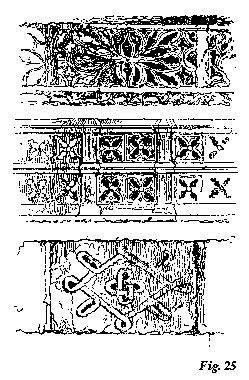286 THE STONES OF VENICE
foot can be sometimes advanced beneath the ledge on which the arm leans, i.e., between the balusters or traceries, which of course cannot be done in the solid parapet: it is also more agreeable to be able to see partially down through the penetrations, than to be obliged to lean far over the edge. The solid parapet was rarely used in Venice after the earlier ages.
§ 18. (2) The Traceried Parapet is chiefly used in the Gothic of the North,  from which the above example, in the Casa Contarini Fasan,1 is directly derived. It is, when well designed, the richest and most beautiful of all forms, and many of the best buildings of France and Germany are dependent for half their effect upon it; its only fault being a slight tendency to fantasticism. It was never frankly received in Venice, where the architects had unfortunately returned to the Renaissance forms before the flamboyant parapets were fully developed in the North; but, in the early stage of the Renaissance, a kind of pierced parapet was employed, founded on the old Byzantine interwoven traceries; that is to say, the slab of stone was pierced here and there with holes, and then an interwoven pattern traced on the surface round them. The difference in system will be understood in a moment by comparing the uppermost example in the figure above, which is a Northern parapet from the Cathedral of Abbeville, with the lowest, from a secret chamber in the Casa Foscari. It will be seen that the Venetian one is far more simple and severe, yet singularly piquant, the black penetrations telling sharply on the plain broad surface. Far inferior in beauty, it has yet one point
from which the above example, in the Casa Contarini Fasan,1 is directly derived. It is, when well designed, the richest and most beautiful of all forms, and many of the best buildings of France and Germany are dependent for half their effect upon it; its only fault being a slight tendency to fantasticism. It was never frankly received in Venice, where the architects had unfortunately returned to the Renaissance forms before the flamboyant parapets were fully developed in the North; but, in the early stage of the Renaissance, a kind of pierced parapet was employed, founded on the old Byzantine interwoven traceries; that is to say, the slab of stone was pierced here and there with holes, and then an interwoven pattern traced on the surface round them. The difference in system will be understood in a moment by comparing the uppermost example in the figure above, which is a Northern parapet from the Cathedral of Abbeville, with the lowest, from a secret chamber in the Casa Foscari. It will be seen that the Venetian one is far more simple and severe, yet singularly piquant, the black penetrations telling sharply on the plain broad surface. Far inferior in beauty, it has yet one point
1 [See Ruskin’s drawing opposite p. 212, Vol. III.]
[Version 0.04: March 2008]
